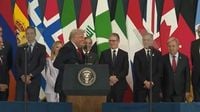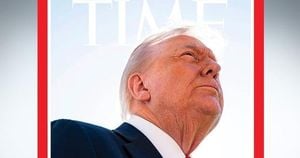India is having quite a moment on the world stage. As the International Monetary Fund (IMF) and the Reserve Bank of India (RBI) release optimistic forecasts for the country’s economy, India is also basking in rare praise from global leaders—including an unexpected public endorsement by U.S. President Donald Trump. These developments come at a time when much of the world is grappling with economic slowdowns and geopolitical instability, making India’s ascent all the more remarkable.
IMF Managing Director Kristalina Georgieva set the tone earlier this week, declaring that India is “emerging as a key driver of global economic growth” while many major economies are losing steam. Speaking just ahead of the IMF-World Bank annual meetings in Washington on October 14, 2025, Georgieva credited India’s strong economic policies and reforms for its standout performance. “India is proving its doubters wrong,” she said, emphasizing that bold reforms and consistent policy efforts have helped the country become one of the fastest-growing economies in the world, according to India Today.
The IMF’s latest projections back up this assessment: India’s GDP is forecast to grow by 6.4% in both 2025 and 2026. This marks an upward revision from earlier estimates, and it leaves India far ahead of other major players. For comparison, China’s economy is expected to expand by 4.8% in 2025 and slow to 4.2% in 2026, while the United States is projected to grow by just 1.9% and 2.0% in those years, respectively. Global growth overall is forecast to remain steady at 3.0% in 2025 and 3.1% in 2026—less than half of India’s rate.
The RBI is even more bullish. At its October monetary policy meeting, the central bank raised its growth outlook for fiscal year 2025-26 to 6.8%, up from a previous estimate of 6.5%. RBI Governor Sanjay Malhotra pointed out that India’s economy grew by a blistering 7.8% in the first quarter of the fiscal year—the fastest pace in nearly two years. “We expect growth to remain healthy through the year, though some moderation could occur due to external headwinds,” Malhotra said, as reported by India Today.
The RBI’s quarterly breakdown projects GDP growth of 7.0% in the second quarter, 6.4% in the third quarter, and 6.2% in the fourth quarter of FY 2025-26, with a forecast of 6.6% for the first quarter of FY 2026-27. This optimism is driven by steady domestic demand, favorable monsoon rains boosting agricultural output, strong private investment, and robust government spending.
Of course, the economic picture isn’t entirely rosy. The RBI has flagged some risks on the horizon, including rising U.S. tariffs on Indian goods—some of which could reach as high as 50%. There are also concerns about global trade weakness and geopolitical uncertainty, any of which could dampen India’s momentum in the short term. Still, both the IMF and RBI believe that India’s domestic economy remains resilient, with consumption expanding and rural demand on the rise. Government initiatives like GST rate rationalization and infrastructure investment are further bolstering long-term prospects, while private sector investments are getting a lift from credit growth and improved corporate balance sheets.
India’s growing economic clout is not going unnoticed on the diplomatic stage. In a striking moment on October 13, 2025, U.S. President Donald Trump, fresh from signing a peace agreement to end the Israel-Hamas war in Gaza, singled out India for praise during a speech in Egypt. Calling India “a great country” and Prime Minister Narendra Modi “his very good friend,” Trump’s remarks came as Pakistan’s Prime Minister Shehbaz Sharif stood nearby, visibly surprised by the unexpected compliment. “India is a great country with a very good friend of mine at the top, and he has just done a fantastic job,” Trump declared, according to Zee News.
Trump didn’t stop there. He expressed optimism about the future of India-Pakistan relations, saying, “I think India and Pakistan are going to live very nicely together,” and turned to Sharif for agreement. The Pakistani leader nodded along, making for a viral moment that was widely shared on social media.
This show of camaraderie comes just days after Prime Minister Modi congratulated President Trump on the success of the Gaza peace plan during a phone call. Modi posted on X (formerly Twitter), “Spoke to my friend, President Trump and congratulated him on the success of the historic Gaza peace plan. Also reviewed the good progress achieved in trade negotiations. Agreed to stay in close touch over the coming weeks.”
The warm words and diplomatic gestures stand in stark contrast to the recent tensions between India and Pakistan. Relations reached a boiling point after the Pahalgam attack on April 22, 2025, in which terrorists killed 26 people. In response, India launched ‘Operation Sindoor’ on May 7, targeting terrorist infrastructure in Pakistan and Pakistan-occupied Jammu and Kashmir (PoJK). Pakistan retaliated with drone and missile attacks, prompting further Indian countermeasures. The situation de-escalated only after Pakistan’s Director General of Military Operations reached out to his Indian counterpart on May 10, leading to a ceasefire announcement.
Meanwhile, the newly appointed U.S. ambassador to India, Sergio Gor, wrapped up a four-day visit to India on October 11, 2025. Gor met with Prime Minister Modi and gifted him a framed photograph of their White House meeting from earlier in the year, signed by President Trump with the message, “Mr Prime Minister, you are great!” In a statement, Ambassador Gor said, “The U.S. values its relationship with India and, under the strong leadership of President Donald J. Trump and Prime Minister Modi, I am optimistic about the days ahead for both of our nations.” He highlighted discussions on defense, trade, technology, and the importance of critical minerals to both countries, according to IANS.
All these developments point to a moment of convergence for India—robust economic prospects, growing diplomatic stature, and a rare sense of optimism from global partners. The country’s ability to maintain growth in the face of global headwinds, while navigating complex geopolitical relationships, is drawing attention from both allies and rivals. As the world’s economic map is redrawn, India seems determined to prove its doubters wrong and stake its claim as a central player in the decades to come.




